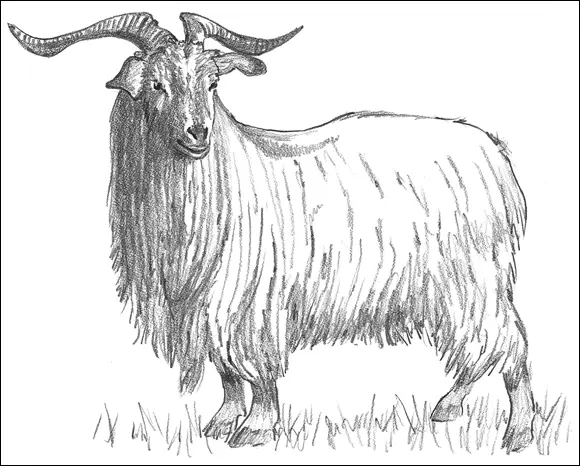Boer goats are large, heavy animals that resemble Nubians because of their Roman noses and floppy ears. They’re white and reddish-brown (although some are all red) or black, as well as spotted and dappled, and many are horned. Their horns are short and curve back close to the head. Bucks can weigh from 260 to 380 pounds and does from 210 to 265 pounds. Figure 3-6 shows a Boer buck.

FIGURE 3-6:A South African Boer buck.
Boers are originally from South Africa, where they were bred for hardiness. They came into the United States from New Zealand and Australia through Canada and continue to grow in popularity. Based on the increased number of men I saw at our local goat conference, the Boers are catching on. (Past conferences have drawn mainly dairy goat owners, who traditionally are women.)
If you want a purebred, high-quality Boer, expect to pay a lot. Boers are one of the most expensive breeds in the United States. That doesn’t mean that all of them are expensive, though; you can still get some good foundation stock (the stock you start your breeding program with) if you look around.
At least two organizations register Boer goats, including the American Boer Goat Association (ABGA) and the United States Boer Goat Association (USBGA).
Boers are quite adaptable and hardy, and most are affectionate and mild-mannered. Their adaptability leads them to browse more than dairy goats because they can easily handle both heat and cold. Boers do have some fairly common genetic defects you need to watch for, including extra teats and abnormal testicles.
 Some breeders of large dairy goats, such as Nubians, cross their does to a Boer bucks. This has the added advantage of selling the kids for milk while freshening the does for another year of milking.
Some breeders of large dairy goats, such as Nubians, cross their does to a Boer bucks. This has the added advantage of selling the kids for milk while freshening the does for another year of milking.
Myotonic goats, also known as fainting or stiff-legged goats, are so named because of their tendency to go rigid and fall down when they’re startled. This is a genetic defect in a recessive gene that probably started in just one goat and then was continued through breeding. The repeated muscle tightening means that the goats have more muscle and are therefore good meat goats.
Fainting goats are often much smaller than Boers, weighing in at between 50 and 75 pounds and becoming no more than 25 inches tall. Those raised for meat, such as the Tennessee Meat Goat, can be much bigger — weighing up to 175 pounds or more.
They come in an array of colors and patterns and have long ears that stick out sideways. They often have long horns that curve backward. They can be shy animals (wouldn’t you be if you kept falling down at the most inopportune times?) but have sweet personalities.
These goats can be registered by either the Myotonic Goat Registry (MGR) or the International Fainting Goat Association (IFGA). These goats are currently listed as “recovering” on the Livestock Conservancy’s list of rare livestock breeds.
 Myotonic goats, because of their diminutive size, may be a better choice for a meat goat breeder who has limited space to work with. The bucks can also be crossed with Boer does to grade up to higher meat production.
Myotonic goats, because of their diminutive size, may be a better choice for a meat goat breeder who has limited space to work with. The bucks can also be crossed with Boer does to grade up to higher meat production.
Some people buy fainting goats for the novelty of scaring them and watching them drop. The goats have allegedly served another purpose — protecting sheep when a predator comes around. The goat drops and the predator eats the goat instead of the sheep. That’s literally a sacrificial goat!
The Kiko goat is a newer breed that was created in New Zealand purely as a meat goat. Kikos are most often white with long, scimitar-like horns and medium ears that stick out sideways. They can gain substantial weight without supplemental feeding, which is a big plus for producers. If you have substantial range for these goats, they may be even more economical than Boers.
 The name Kiko means “meat for consumption” in the Maori language. This unique breed came out of a government-funded project intended to thin out the native goat population. Once captured, some of the native goats were crossbred with milk and fiber goats with the intent of developing hardy goats that grew fast and produced a lot of meat.
The name Kiko means “meat for consumption” in the Maori language. This unique breed came out of a government-funded project intended to thin out the native goat population. Once captured, some of the native goats were crossbred with milk and fiber goats with the intent of developing hardy goats that grew fast and produced a lot of meat.
Kikos came into the United States in the 1990s and were found to be superior to the Boer goat in terms of hardiness and adaptability. Their hooves have to be trimmed less frequently than other goats, they kid easily, and the does are good mothers. These traits make them perfect for a life on the range.
Kiko goats and offspring from crosses with other meat goats can be registered with the International Kiko Goat Association. They officially recognize a Boer/Kiko cross called the American Meatmaker. The American Kiko Goat Association (AKGA) allows some crossbreed registration, but the sire must always be a purebred Kiko.
 Spanish goats, also called brush goats, scrub goats, and woods goats, are usually medium-sized and lanky with long horns that often twist at the end. They come in all colors and mostly have short hair but can also have long hair. They are known to be crossed with Nubian, Angora, Boer, and Alpine or other Swiss breeds, which you can often recognize by their looks. Those that are crossed with Cashmere goats can also serve as fiber goats. Figure 3-7 shows a Cashmere Spanish goat.
Spanish goats, also called brush goats, scrub goats, and woods goats, are usually medium-sized and lanky with long horns that often twist at the end. They come in all colors and mostly have short hair but can also have long hair. They are known to be crossed with Nubian, Angora, Boer, and Alpine or other Swiss breeds, which you can often recognize by their looks. Those that are crossed with Cashmere goats can also serve as fiber goats. Figure 3-7 shows a Cashmere Spanish goat.
If you decide to get a Spanish goat, you will also be getting a little bit of U.S. history. These goats were originally brought over from Spain in the 16th century and evolved into nearly indigenous goats in the southern United States. Because they were feral, they are much hardier than goats such as the Boer so they make good, easy-care meat goats, much like the Kiko.
The American Livestock Breeds Conservancy has developed standards for the Spanish goat and formed the Spanish Goat Association (SGA). Its goal is to find Spanish goats and breeders in the United States to preserve the gene pool. The number of breeders is limited, and so far none operate in the West or Northeast.

FIGURE 3-7:A long-haired Spanish goat, also considered Cashmere.
 If you want to learn more about true Spanish goats or even get a few, check out the SGA at
If you want to learn more about true Spanish goats or even get a few, check out the SGA at www.spanishgoats.org .
The Texmaster is a moderate-sized meat goat and a trademarked cross between Boers and Tennessee meat goats (myotonics) developed by Onion Creek Ranch in Texas. They usually don’t “faint,” but they do add to the meatiness of the breed.
Читать дальше


 Some breeders of large dairy goats, such as Nubians, cross their does to a Boer bucks. This has the added advantage of selling the kids for milk while freshening the does for another year of milking.
Some breeders of large dairy goats, such as Nubians, cross their does to a Boer bucks. This has the added advantage of selling the kids for milk while freshening the does for another year of milking. The name Kiko means “meat for consumption” in the Maori language. This unique breed came out of a government-funded project intended to thin out the native goat population. Once captured, some of the native goats were crossbred with milk and fiber goats with the intent of developing hardy goats that grew fast and produced a lot of meat.
The name Kiko means “meat for consumption” in the Maori language. This unique breed came out of a government-funded project intended to thin out the native goat population. Once captured, some of the native goats were crossbred with milk and fiber goats with the intent of developing hardy goats that grew fast and produced a lot of meat.











